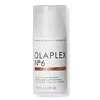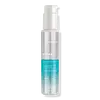What's inside
What's inside
 Key Ingredients
Key Ingredients

No key ingredients
 Benefits
Benefits

 Concerns
Concerns

 Ingredients Side-by-side
Ingredients Side-by-side

Water
Skin ConditioningCetearyl Alcohol
EmollientDimethicone
EmollientIsohexadecane
EmollientCoco-Caprylate
EmollientNeopentyl Glycol Diheptanoate
EmollientBehentrimonium Chloride
PreservativeIsododecane
EmollientPhenyl Trimethicone
Skin ConditioningPropanediol
SolventBis-Aminopropyl Diglycol Dimaleate
Skin ConditioningParfum
MaskingCetrimonium Chloride
AntimicrobialPhenoxyethanol
PreservativeGlyceryl Stearate
EmollientIsopropyl Alcohol
SolventHydroxyethylcellulose
Emulsion StabilisingHydroxypropyl Guar
Emulsion StabilisingSodium Stearoyl Lactylate
EmulsifyingHydroxypropyl Cyclodextrin
MaskingHexyl Cinnamal
PerfumingLimonene
PerfumingCitral
PerfumingHydrolyzed Vegetable Protein Pg-Propyl Silanetriol
Skin ConditioningDisodium EDTA
Linalool
PerfumingCitronellol
PerfumingIodopropynyl Butylcarbamate
PreservativeHydroxycitronellal
PerfumingEtidronic Acid
Tocopherol
AntioxidantGeraniol
PerfumingPotassium Sorbate
PreservativeHelianthus Annuus Seed Oil
EmollientPhytantriol
HumectantSodium Benzoate
MaskingPseudozyma Epicola/Camellia Sinensis Seed Oil Ferment Extract Filtrate
HumectantTocopheryl Acetate
AntioxidantVitis Vinifera Seed Oil
EmollientAloe Barbadensis Leaf Juice
Skin ConditioningPanthenol
Skin ConditioningCitric Acid
BufferingGigartina Stellata Extract
Skin ProtectingChondrus Crispus Extract
Skin ConditioningAscorbic Acid
AntioxidantCocos Nucifera Oil
MaskingWater, Cetearyl Alcohol, Dimethicone, Isohexadecane, Coco-Caprylate, Neopentyl Glycol Diheptanoate, Behentrimonium Chloride, Isododecane, Phenyl Trimethicone, Propanediol, Bis-Aminopropyl Diglycol Dimaleate, Parfum, Cetrimonium Chloride, Phenoxyethanol, Glyceryl Stearate, Isopropyl Alcohol, Hydroxyethylcellulose, Hydroxypropyl Guar, Sodium Stearoyl Lactylate, Hydroxypropyl Cyclodextrin, Hexyl Cinnamal, Limonene, Citral, Hydrolyzed Vegetable Protein Pg-Propyl Silanetriol, Disodium EDTA, Linalool, Citronellol, Iodopropynyl Butylcarbamate, Hydroxycitronellal, Etidronic Acid, Tocopherol, Geraniol, Potassium Sorbate, Helianthus Annuus Seed Oil, Phytantriol, Sodium Benzoate, Pseudozyma Epicola/Camellia Sinensis Seed Oil Ferment Extract Filtrate, Tocopheryl Acetate, Vitis Vinifera Seed Oil, Aloe Barbadensis Leaf Juice, Panthenol, Citric Acid, Gigartina Stellata Extract, Chondrus Crispus Extract, Ascorbic Acid, Cocos Nucifera Oil
Water
Skin ConditioningDimethicone
EmollientCetearyl Alcohol
EmollientPhenoxyethanol
PreservativeSimmondsia Chinensis Seed Oil
EmollientCarthamus Tinctorius Seed Oil
MaskingCrambe Abyssinica Seed Oil Phytosterol Esters
EmulsifyingCocos Nucifera Oil
MaskingChlorella Vulgaris Extract
Skin ConditioningHydrolyzed Algin
Arginine Hcl
Skin ConditioningRosa Canina Fruit Oil
EmollientSea Water
HumectantLaurdimonium Hydroxypropyl Hydrolyzed Keratin
Skin ConditioningPhosphatidylcholine
EmulsifyingBehentrimonium Chloride
PreservativeGlyceryl Stearate Se
EmulsifyingPolyquaternium-37
Dicaprylyl Carbonate
EmollientIsopropyl Alcohol
SolventSodium Gluconate
Skin ConditioningGlyceryl Laurate
EmollientLauryl Glucoside
CleansingSodium Benzoate
MaskingPotassium Sorbate
PreservativeCitric Acid
BufferingLinalool
PerfumingLimonene
PerfumingParfum
MaskingWater, Dimethicone, Cetearyl Alcohol, Phenoxyethanol, Simmondsia Chinensis Seed Oil, Carthamus Tinctorius Seed Oil, Crambe Abyssinica Seed Oil Phytosterol Esters, Cocos Nucifera Oil, Chlorella Vulgaris Extract, Hydrolyzed Algin, Arginine Hcl, Rosa Canina Fruit Oil, Sea Water, Laurdimonium Hydroxypropyl Hydrolyzed Keratin, Phosphatidylcholine, Behentrimonium Chloride, Glyceryl Stearate Se, Polyquaternium-37, Dicaprylyl Carbonate, Isopropyl Alcohol, Sodium Gluconate, Glyceryl Laurate, Lauryl Glucoside, Sodium Benzoate, Potassium Sorbate, Citric Acid, Linalool, Limonene, Parfum
 Reviews
Reviews

Ingredients Explained
These ingredients are found in both products.
Ingredients higher up in an ingredient list are typically present in a larger amount.
This ingredient is a preservative and often used for it's anti-static properties. You'll most likely see this ingredient in hair conditioners.
It does not cause irritation or sensitization in leave-on products at 1-5%.
Cetearyl alcohol is a mixture of two fatty alcohols: cetyl alcohol and stearyl alcohol. It is mainly used as an emulsifier. Emulsifiers help prevent the separation of oils and products. Due to its composition, it can also be used to thicken a product or help create foam.
Cetearyl alcohol is an emollient. Emollients help soothe and hydrate the skin by trapping moisture.
Studies show Cetearyl alcohol is non-toxic and non-irritating. The FDA allows products labeled "alcohol-free" to have fatty alcohols.
This ingredient is usually derived from plant oils such as palm, vegetable, or coconut oils. There is debate on whether this ingredient will cause acne.
Due to the fatty acid base, this ingredient may not be Malassezia folliculitis safe.
Learn more about Cetearyl AlcoholCitric Acid is an alpha hydroxy acid (AHA) naturally found in citrus fruits like oranges, lemons, and limes.
Like other AHAs, citric acid can exfoliate skin by breaking down the bonds that hold dead skin cells together. This helps reveal smoother and brighter skin underneath.
However, this exfoliating effect only happens at high concentrations (20%) which can be hard to find in cosmetic products.
Due to this, citric acid is usually included in small amounts as a pH adjuster. This helps keep products slightly more acidic and compatible with skin's natural pH.
In skincare formulas, citric acid can:
While it can provide some skin benefits, research shows lactic acid and glycolic acid are generally more effective and less irritating exfoliants.
Most citric acid used in skincare today is made by fermenting sugars (usually from molasses). This synthetic version is identical to the natural citrus form but easier to stabilize and use in formulations.
Read more about some other popular AHA's here:
Learn more about Citric AcidCocos Nucifera Oil is obtained from the kernels of the coconut fruit. In other words, this is coconut oil.
Coconut Oil is rich in fatty acids with lauric acid making up the majority of these. It also contains linoleic acid. Due to this high fatty acid content, coconut oil helps trap moisture and soften skin.
Despite being antibacterial, coconut oil may not be great for acne-prone skin. It is comedogenic and may clog pores. This ingredient may not be safe for malassezia or fungal acne.
Note: Coconut Oil should not replace your sunscreen for UV protection. Studies show it only blocks about 20% of UV.
This oil is non-volatile and has a light scent.
The term 'fragrance' is not regulated in many countries. In many cases, it is up to the brand to define this term. For instance, many brands choose to label themselves as "fragrance-free" because they are not using synthetic fragrances. However, their products may still contain ingredients such as essential oils that are considered a fragrance.
Learn more about Cocos Nucifera OilDimethicone is a type of synthetic silicone created from natural materials such as quartz.
What it does:
Dimethicone comes in different viscosities:
Depending on the viscosity, dimethicone has different properties.
Ingredients lists don't always show which type is used, so we recommend reaching out to the brand if you have questions about the viscosity.
This ingredient is unlikely to cause irritation because it does not get absorbed into skin. However, people with silicone allergies should be careful about using this ingredient.
Note: Dimethicone may contribute to pilling. This is because it is not oil or water soluble, so pilling may occur when layered with products. When mixed with heavy oils in a formula, the outcome is also quite greasy.
Learn more about DimethiconeIsopropyl Alcohol is more commonly known as rubbing alcohol. It is most commonly used as a solvent, meaning it helps other ingredients dissolve.
This ingredient is an astringent alcohol. Astringent alcohols may also irritate skin as they high amounts may strip away your skin's natural oils.
Other types of astringent alcohols include:
According to the National Rosacea Society based in the US, you should be mindful of products with these alcohols in the top half of ingredients.
Any type of sanitizing product will have high amounts of alcohol to help kill bacteria and viruses.
Learn more about Isopropyl AlcoholLimonene is a fragrance that adds scent and taste to a formulation.
It's found in the peel oil of citrus fruits and other plants such as lavender and eucalyptus. The scent of limonene is generally described as "sweet citrus".
Limonene acts as an antioxidant, meaning it helps neutralize free radicals.
When exposed to air, oxidized limonene may sensitize the skin. Because of this, limonene is often avoided by people with sensitive skin.
The term 'fragrance' is not regulated in many countries. In many cases, it is up to the brand to define this term. For instance, many brands choose to label themselves as "fragrance-free" because they are not using synthetic fragrances. However, their products may still contain ingredients such as essential oils that are considered a fragrance.
Learn more about LimoneneLinalool is a fragrance and helps add scent to products. It's derived from common plants such as cinnamon, mint, citrus, and lavender.
Like Limonene, this ingredient oxidizes when exposed to air. Oxidized linalool can cause allergies and skin sensitivity.
This ingredient has a scent that is floral, spicy tropical, and citrus-like.
Learn more about LinaloolParfum is a catch-all term for an ingredient or more that is used to give a scent to products.
Also called "fragrance", this ingredient can be a blend of hundreds of chemicals or plant oils. This means every product with "fragrance" or "parfum" in the ingredients list is a different mixture.
For instance, Habanolide is a proprietary trade name for a specific aroma chemical. When used as a fragrance ingredient in cosmetics, most aroma chemicals fall under the broad labeling category of “FRAGRANCE” or “PARFUM” according to EU and US regulations.
The term 'parfum' or 'fragrance' is not regulated in many countries. In many cases, it is up to the brand to define this term.
For instance, many brands choose to label themselves as "fragrance-free" because they are not using synthetic fragrances. However, their products may still contain ingredients such as essential oils that are considered a fragrance by INCI standards.
One example is Calendula flower extract. Calendula is an essential oil that still imparts a scent or 'fragrance'.
Depending on the blend, the ingredients in the mixture can cause allergies and sensitivities on the skin. Some ingredients that are known EU allergens include linalool and citronellol.
Parfum can also be used to mask or cover an unpleasant scent.
The bottom line is: not all fragrances/parfum/ingredients are created equally. If you are worried about fragrances, we recommend taking a closer look at an ingredient. And of course, we always recommend speaking with a professional.
Learn more about ParfumPhenoxyethanol is a preservative that has germicide, antimicrobial, and aromatic properties. Studies show that phenoxyethanol can prevent microbial growth. By itself, it has a scent that is similar to that of a rose.
It's often used in formulations along with Caprylyl Glycol to preserve the shelf life of products.
Potassium Sorbate is a preservative used to prevent yeast and mold in products. It is commonly found in both cosmetic and food products.
This ingredient comes from potassium salt derived from sorbic acid. Sorbic acid is a natural antibiotic and effective against fungus.
Both potassium sorbate and sorbic acid can be found in baked goods, cheeses, dried meats, dried fruit, ice cream, pickles, wine, yogurt, and more.
You'll often find this ingredient used with other preservatives.
Learn more about Potassium SorbateSodium Benzoate is a preservative. It's used in both cosmetic and food products to inhibit the growth of mold and bacteria. It is typically produced synthetically.
Both the US FDA and EU Health Committee have approved the use of sodium benzoate. In the US, levels of 0.1% (of the total product) are allowed.
Sodium benzoate works as a preservative by inhibiting the growth of bacteria inside of cells. It prevents the cell from fermenting a type of sugar using an enzyme called phosphofructokinase.
It is the salt of benzoic acid. Foods containing sodium benzoate include soda, salad dressings, condiments, fruit juices, wines, and snack foods.
Studies for using ascorbic acid and sodium benzoate in cosmetics are lacking, especially in skincare routines with multiple steps.
We always recommend speaking with a professional, such as a dermatologist, if you have any concerns.
Learn more about Sodium BenzoateWater. It's the most common cosmetic ingredient of all. You'll usually see it at the top of ingredient lists, meaning that it makes up the largest part of the product.
So why is it so popular? Water most often acts as a solvent - this means that it helps dissolve other ingredients into the formulation.
You'll also recognize water as that liquid we all need to stay alive. If you see this, drink a glass of water. Stay hydrated!
Learn more about Water